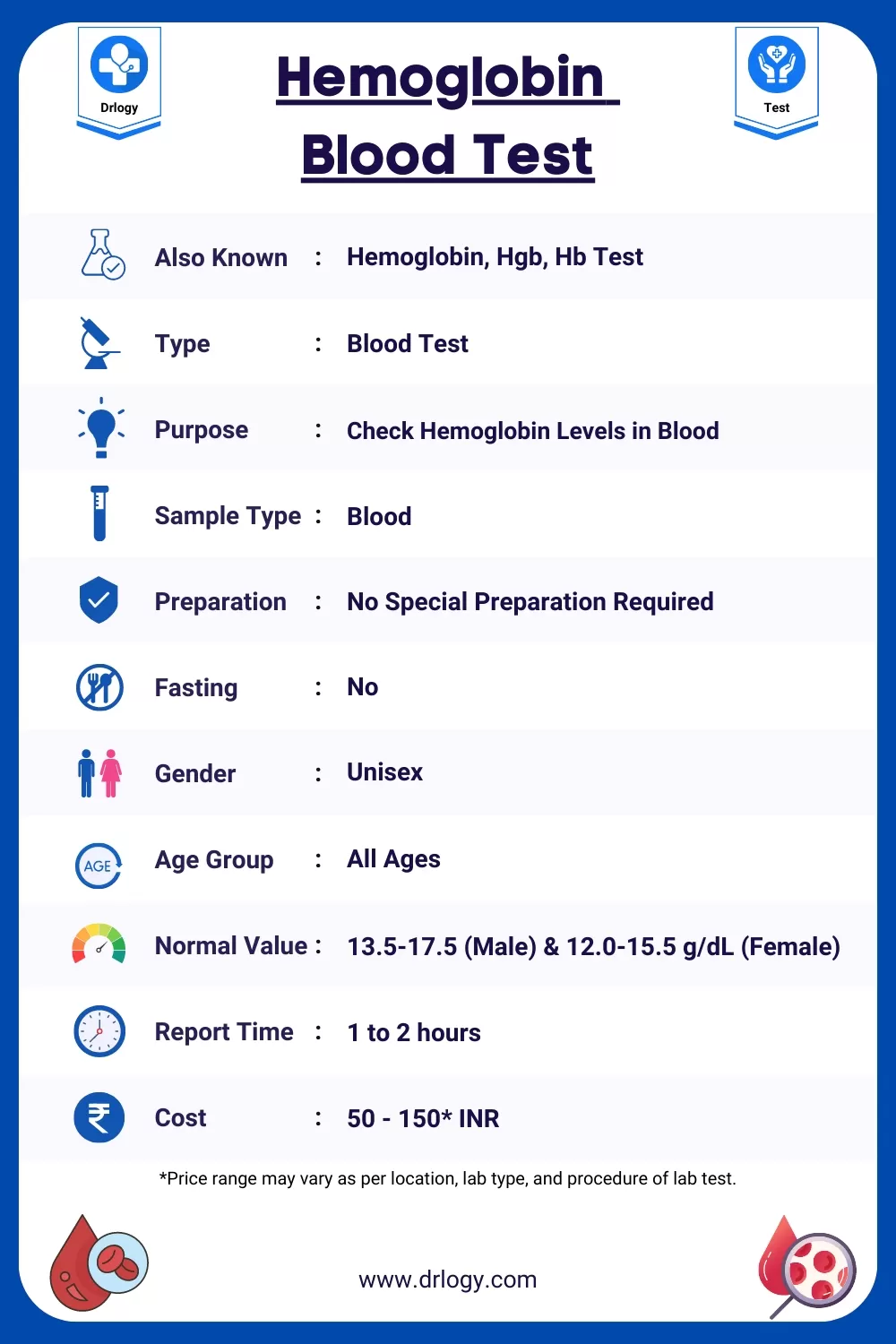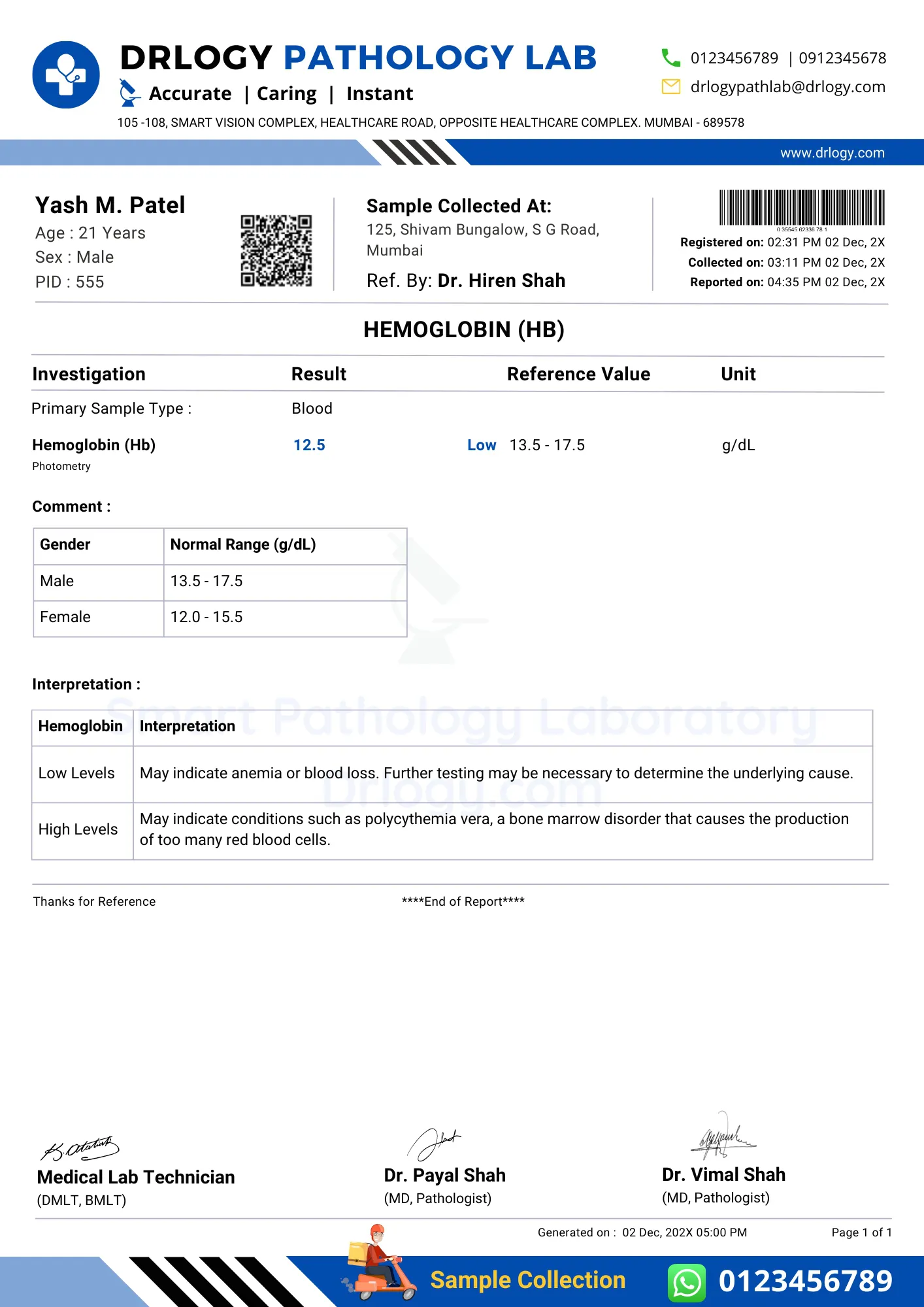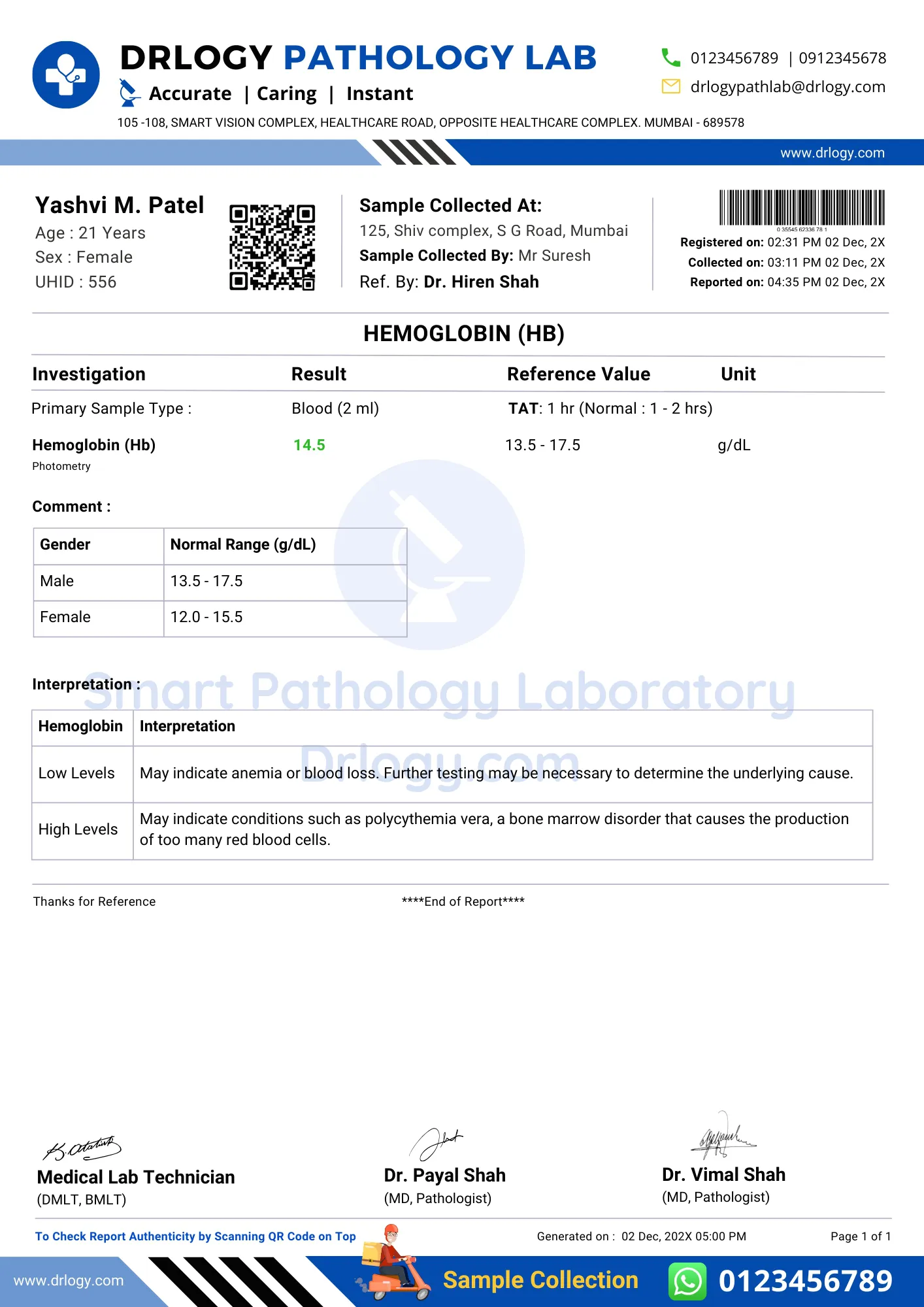
The hemoglobin blood test measures the amount of hemoglobin in your blood. Hemoglobin is a protein in your red blood cells that carries oxygen to your body's organs and tissues and transports carbon dioxide back to your lungs.
Here are the basic details for Hemoglobin Blood Test.
| Also Known As | Hemoglobin, Hgb, Hb Test |
| Type | Blood Test |
| Purpose |
Check Hemoglobin Levels in Blood |
| Sample Type | Blood |
| Preparation | No Special Preparation Required |
| Fasting | No |
| Gender | Unisex |
| Age-Group | All Ages |
| Normal Value | 13.5 to 17.5 (Male) & 12.0 to 15.5 g/dL (Female) |
| Reporting Time | 1 to 2 hours |
| Cost | 50 - 150* INR |
*Price range may vary as per location, lab type, and procedure of lab test.
Interesting Facts About Hemoglobin
- Hemoglobin is an iron-containing protein found in red blood cells.
- It is responsible for transporting oxygen from the lungs to body tissues.
- Hemoglobin gives blood its red color.
Here are some purposes of a hemoglobin blood test:

Here are some steps to prepare for a hemoglobin blood test before, during, and after the test:
Summary
Prepare for a hemoglobin blood test by following instructions, staying hydrated, and applying pressure post-test.
Here are the steps involved in a hemoglobin blood test procedure:


Hemoglobin Blood Normal Test Report PDF Format

Hemoglobin Blood Abnormal Test Report PDF Format
Here is a table of the normal hemoglobin values for adults based on sex:
| Gender | Normal Hemoglobin Range |
|---|---|
| Male | 13.5 to 17.5 grams per deciliter (g/dL) |
| Female | 12.0 to 15.5 g/dL |
here is an example table that includes reference ranges and general interpretations of hemoglobin levels:
|
Hemoglobin Levels (g/dL) |
Interpretation |
|---|---|
|
May indicate anemia or blood loss. Further testing may be necessary to determine the underlying cause. |
|
Generally considered healthy, other factors such as symptoms or medical history should be considered. |
|
May indicate conditions such as polycythemia vera, a bone marrow disorder that causes the production of too many red blood cells. |
Here are the specimen requirements for the hemoglobin blood Test.
| Specimen | Whole Blood |
| Volume | 1 mL |
| Container | Heparinized Syringe |
Here are some of the common causes of high hemoglobin levels in a blood test:
| Cause | Description |
|---|---|
| Dehydration | When the body loses fluids and the blood becomes more concentrated, the hemoglobin levels can appear high. |
| Lung Disease | Certain lung diseases, such as emphysema, can cause low levels of oxygen in the blood, which can trigger the production of more red blood cells and lead to high hemoglobin levels. |
| Polycythemia Vera | A rare blood disorder that causes the bone marrow to produce too many red blood cells, which can result in high hemoglobin levels. |
| Smoking | Smoking can cause a decrease in oxygen levels in the blood, which can lead to the production of more red blood cells and higher hemoglobin levels. |
| Living at high altitudes | At high altitudes, the body produces more red blood cells to compensate for the lower oxygen levels in the air, which can result in high hemoglobin levels. |
| Certain medications | Some medications, such as anabolic steroids and testosterone, can stimulate the production of red blood cells and cause high hemoglobin levels. |
| Kidney disease or tumors | Certain kidney conditions or tumors can cause the body to produce more erythropoietin, a hormone that stimulates the production of red blood cells and can lead to high hemoglobin levels. |
| Congenital heart disease | Some congenital heart defects can cause the body to produce more red blood cells, resulting in high hemoglobin levels. |
| Sleep apnea | Sleep apnea can cause low levels of oxygen in the blood, which can trigger the production of more red blood cells and lead to high hemoglobin levels. |
Here are some common causes of low hemoglobin levels in a table format:
| Cause | Description |
|---|---|
| Nutritional deficiencies | Low levels of iron, vitamin B12, and folate can lead to decreased hemoglobin production. |
| Blood loss | Acute or chronic blood loss can result in low hemoglobin levels. |
| Chronic diseases | Chronic diseases such as kidney disease, liver disease, and cancer can lead to decreased hemoglobin production. |
| Inherited disorders | Inherited disorders such as thalassemia and sickle cell anemia can cause low hemoglobin levels. |
| Pregnancy | Hemoglobin levels may naturally decrease during pregnancy. |
| Medications | Certain medications, such as chemotherapy drugs, can lead to decreased hemoglobin production. |
| Bone marrow disorders | Disorders that affect the bone marrow, such as aplastic anemia or myelodysplastic syndrome, can cause low hemoglobin levels. |
Summary
High levels of hemoglobin can be caused by conditions like polycythemia or lung disease, while low levels can indicate anemia or blood loss.
Here are some possible limitations of the Hemoglobin Blood Test.
Here is the potential risk factor of the Hemoglobin Blood Test.
Here are Doctor recommendations or consult a specialist after Hemoglobin Blood Test.
| Hemoglobin Result | Doctor to Visit | Reason to Visit |
|---|---|---|
| High | Hematologist | Investigate potential blood disorders |
| Normal | Primary Care Doctor | Routine follow-up or further evaluation |
| Low | Internist or Hematologist | Assess for anemia or other conditions affecting hemoglobin levels |
Here are the estimated Hemoglobin Blood Test Price in India with different top cities:
| City | Price Range (INR)* |
|---|---|
| Mumbai | 50 - 150 |
| New Delhi | 100 - 150 |
| Bangalore | 50 - 150 |
| Hyderabad | 100 - 150 |
| Kolkata | 50 - 150 |
| Pune | 100 - 150 |
| Lucknow | 50 - 150 |
| Noida | 50 - 150 |
| Surat | 100 - 150 |
| Gurugram | 100 - 150 |
| Patna | 50 - 150 |
| Chennai | 50 - 150 |
| Jaipur | 50 - 150 |
| Ahmedabad | 100 - 150 |
*Prices are approximate and vary depending on a specific laboratory or healthcare facility.
Summary
Overall, the hemoglobin blood test is a valuable tool for diagnosing and monitoring a variety of blood-related conditions. Also check Drlogy Test for detailed information about all medical tests for patients, doctors, scholers and medical students.
Reference
A hemoglobin blood test is a common laboratory test that measures the amount of hemoglobin in the blood.
A hemoglobin blood test is done to evaluate the overall health of a person's blood and to assess their oxygen-carrying capacity.
The hemoglobin blood test requires a small blood sample, usually obtained through a quick and simple blood draw from a vein in the arm.
The normal range for hemoglobin levels varies depending on age, sex, and other factors.
DOCTOR'S MOST TRUSTED HEALTHCARE PLATFORM
10M+Patients
30000+Doctors
25000+Hospitals/Labs